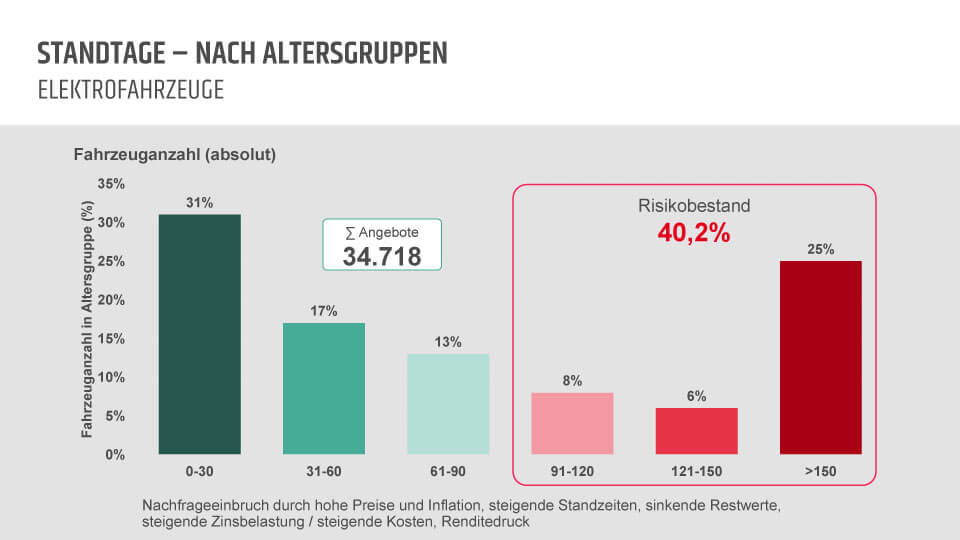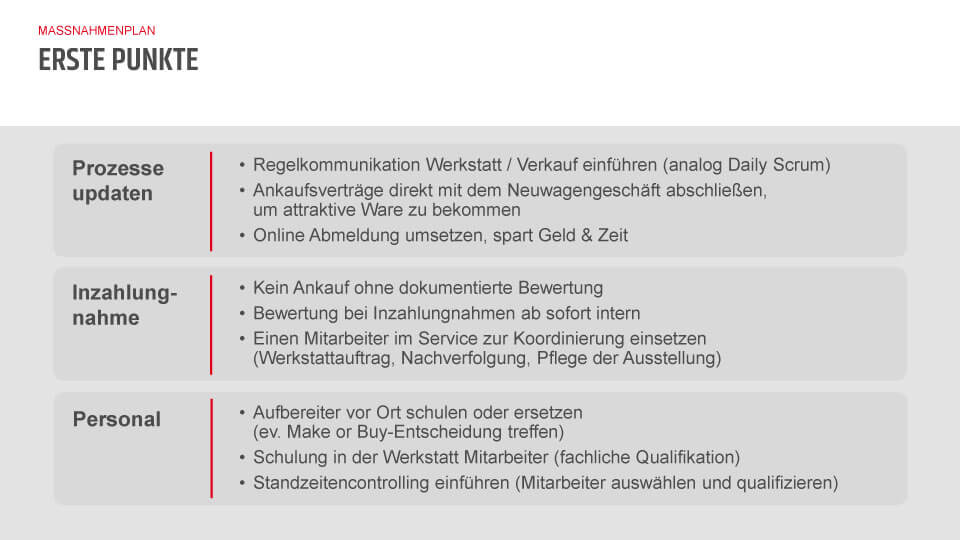First aid plan for used electric vehicles
Success is not a product of chance. Rather, it is based on sustainable, data-based processes and highly professional, individual advice.
The training and consulting specialist recently explained how Promotor specifically advises the automobile trade in its fundamentally important used car business and enables them to generate convincing additional profits in its digital press conference using a practical example.
The market for used electric vehicles is taking a nosedive. The reasons are varied: high vehicle prices, inflation and ongoing skepticism about electric cars among consumers are slowing demand. The current residual values are in a downward trend, interest rates and costs are climbing. Increasing downtimes are also massively increasing the pressure on car dealerships' returns (see Fig. 1). “Almost half of all used e-vehicles are currently sitting in dealers’ yards for between 90 and more than 150 days,” says Andreas Serra, Managing Director of Promotor, summing up the used e-car situation with a view to the high level of risk. As Serra explains at the start of the first web session with journalists, dealers are currently finding it very difficult to make money with used BEVs. For the DAT subsidiary, which has had comprehensive market and vehicle data as well as first-class digital expert knowledge in the industry since its integration into the automotive data service provider, creating the right action plan and targeted de-escalation measures for the automotive companies' used car business is a top priority to get this back on the road to success.
Promotor compares his approach to counseling with that of a doctor. “If a patient has symptoms, they seek relief from a doctor. Like a doctor, we also treat our partners. “After our first data-based, digital remote analysis called QuickCheck – analogous to the anamnesis and various imaging procedures such as CT or MRI in medicine – the automobile dealers receive appropriate treatment recommendations from us,” says Serra. Then you decide on specific supportive measures or forms of therapy and implement them to help the motor vehicle trade recover - and with a guarantee of success. Mutual trust always forms the basis of the cooperation between the promoter and his customers.

Fig. 1: High risk inventory: Almost half of all used e-vehicles sit on dealers' yards for between 90 and more than 150 days
Practical example from a dealer
Using a practical example from the used car area of a car dealership, Promotor showed in detail in his web session how data-based advice to the dealer works - initially from a distance and later on site. In addition, it was explained what optimization potential can be achieved in the used car business area by shortening idle days and/or higher revenue from vehicle sales compared to the competition. “For our practical example, a car dealership at two locations in western Germany with 361 used cars sold annually, our QuickCheck analysis showed daytime costs per vehicle sold of 1.390 euros. In contrast, the majority of competitors in their region were significantly lower, with daily costs between 794 and 995 euros per vehicle sold,” explains Nils Weber, Promoter Head of Digital Business Development, the results of the QuickCheck.
However, the example dealer presented itself significantly better than the competition in terms of vehicle revenue. The car dealership generated additional revenue of 1.590 euros per vehicle sold. According to Weber, the goal was now to reduce the partner's daytime costs for all 361 used vehicles sold by 440 euros while maintaining the same additional revenue. The total optimization potential predicted by Promotor amounting to 158.840 euros was impressive for the car dealership. According to Weber, the on-site comparison based on the car dealership's actual sales list ultimately confirmed the possible additional profit for the dealer, despite marginal deviations. The promoter was thus able to guarantee the dealer the additional profit mentioned and the car dealership took part in the subsequent consultation and implementation.
First, take measures with quick results
According to Richard Schneider, Promotor Head of Consulting, the consulting process according to Promotor Standards was initially scheduled to last around six months. After reviewing the various GW topics - from purchasing/acquisition to presentation, marketing or digital performance through to marketing and implementation of the GW standards - the weak points were identified. The next steps were employee interviews and spot checks based on the partner's DMS numbers. It was then decided to first implement measures that promised the quickest success. According to Schneider, these were more efficient communication between sales and workshops, consistent execution of purchase contracts directly with the new car business, online vehicle registrations and a consistently documented evaluation of used vehicles when purchasing them (see Fig. 2). Further steps now concern updates of individual processes or the clarification of important personnel issues. “Ultimately, the decisive factor for success in our practical example is that we always closely monitor the action plan,” says Schneider from experience. Ultimately, it’s always about people and motivation.

Fig. 2: Promoter action plan with guaranteed success: close support from experts
“Kingdoms” in the car dealership must be dissolved
Looking back, according to Andreas Serra, the assessment of the car dealership that Promotor had commissioned with the advice was unspecific, but correct. The analyzes clearly proved this with their identified “pain points” in the used car area of the car dealership and the calculated optimization potential. “A lot of money was left on the table just because the car dealership was standing for a long time,” says the promoter managing director. Now it is important to continue consistently implementing the measures decided with the car dealership. The car dealership's used car process needs a new structure with a focus on the interaction between workshop and sales. Here you are in the middle of it all. “In the next step, existing 'kingdoms' in the car dealership must be dissolved, a functioning used car team must be put together and clear responsibilities must be defined and installed,” emphasizes Serra, with a view to the therapy effort required for the dealer's further recovery. Given the turbulence on the used car market and the high level of risk associated with BEVs, it is certainly a challenging task to get the car dealership back on track as quickly as possible. In any case, it is clear that it works. Ultimately, this is what Promoter stands for with its guarantee of success.

